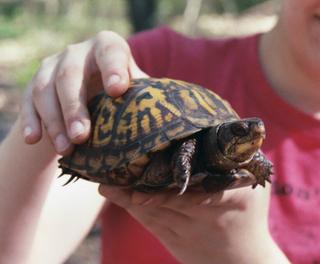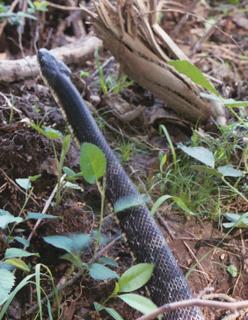I had started at the mind-blowing Menatico Ponds WMA. I’m not sure about the geological history of the place, but it looks like someone took the standard pine-oak woods of South Jersey and dug out ponds really close together with a giant icecream scoop. The sun hadn’t burned off all the mist yet, and I wandered around between these angelic little ponds on the ridges in between, marveling at the landscape and finding next to no herps. I caught a glimpse of a fence lizard (Sceloporus undulatus hyacinthinatus) on a stump and saw one toad smooshed on a dirt road.

I decided to try my favorite WMA before I headed home, and on the way there I saw one large black racer (Coluber constrictor constrictor) DOR, and two box turtles (Terrapene carolina carolina) alive on the road. The first one I saw being helped off the road by a very nice woman. The second one I thought was a rock, but I turned around and came back just to be sure. I dropped it a few yards off the road in the direction it was heading [When helping turtles across the road, always take them in the direction they’re moving. If you don’t they’ll turn around and try to cross again].
When I got to the WMA I tried the usual trash and debris. I found the big wormsnake under the famous black rubber mat, and then spent a lot of time trying to flush a really big green frog (Rana clamitans melatona) out from a puddle to get a picture of it. Usually these guys dive to the mud at the bottom and you can’t find them anymore. This one had chosen a relatively small puddle, so I squatted there with my hands in the mud, feeling around like a raccoon. I grabbed it several times, but holding onto a wet frog in mud is not easy. I bought a small net a month ago just for this kind of occasion, but did I remember to bring it? Anyhow, I gave up, found some large tadpoles in another very large puddle, and then decided to head back to the car.
 I was cutting back on one of the dirt roads that runs between the woods and one of the fields when I spotted this gorgeous beast – a black ratsnake (Elaphe obsoleta obsoleta) –leisurely poking around some logs. I got my camera out and grabbed it by the tail as I took a couple of bad pictures. I got a much better more interesting series of shots when I let go and it climbed up a cherry tree. What a hunk of a snake. Most snakes get away from you in a panic, this one got away in no rush whatsoever, like it only wanted its privacy and didn’t feel like having its picture taken. I don’t know why a snake this beautiful wouldn’t want its picture taken, but I let it beat its dignified retreat up the
I was cutting back on one of the dirt roads that runs between the woods and one of the fields when I spotted this gorgeous beast – a black ratsnake (Elaphe obsoleta obsoleta) –leisurely poking around some logs. I got my camera out and grabbed it by the tail as I took a couple of bad pictures. I got a much better more interesting series of shots when I let go and it climbed up a cherry tree. What a hunk of a snake. Most snakes get away from you in a panic, this one got away in no rush whatsoever, like it only wanted its privacy and didn’t feel like having its picture taken. I don’t know why a snake this beautiful wouldn’t want its picture taken, but I let it beat its dignified retreat up the  tree.
tree.

